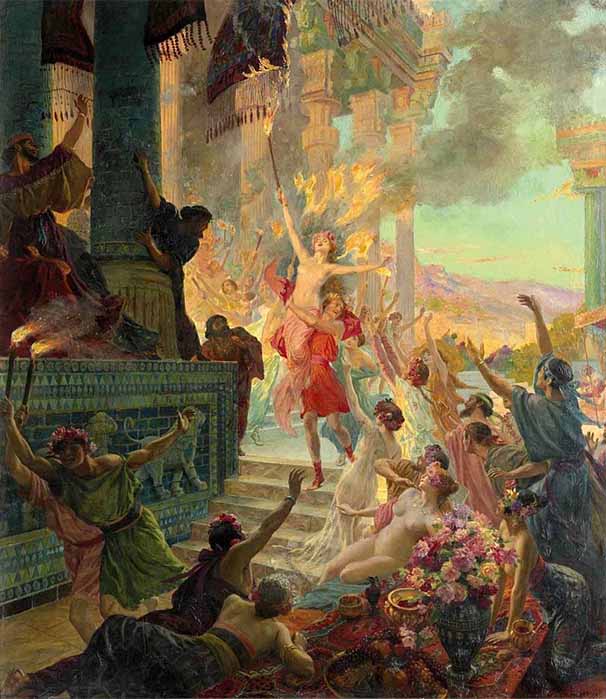
The Aftermath Of The Achaemenid Empire
Between 550 and 520 BC Cyrus the Great had unified the Medes and the Persians and founded an empire that stretched from the Indus River to North Africa and from the Aral Sea to the Persian Gulf. Professor Richard Frye, of Iranian Studies, Harvard University, in the foreword to Iran Seven Faces of Civilization, describes it as such: “The Achaemenid Persians established an empire unprecedented in the history of mankind, for they were truly magnanimous to their subject peoples, ready to tolerate and even to absorb foreign ideas.” At the foot of Kuh-e Rahmat, Mountain of Mercy, on the Marvdasht plain, King Darius the Great, and his successors Xerxes and Artaxerxes, built one of the most spectacular cities in the world – Persepolis.

At the foot of Kuh-e Rahmat, Mountain of Mercy, lies Persepolis (Dario Bajurin / Abode Stock)
Destruction Of Persepolis
After escaping an ambush laid by a contingent of Darius III’s forces at the Persian Gates, Alexander the Great pursued the satrap of Persis, Ariobarzanes, who fled with the remains of his army to this plain of Marvdasht, but the guardian of Persepolis, Tiridates, refused to open the gates to provide refuge to his fleeing countrymen. Alexander slew Ariobarzanes and rode triumphantly through the now open Gates of All Nations (Old Persian: duvarthim visadahyum) of Persepolis, and the Lamassu, the Assyrian statutes of winged bulls with human heads intended as semi-divine protectors of the city, offered no resistance to his entrance. Alexander considered himself King of Kings and a rightful heir to the Achaemenid Dynasty.
Alexander and his troops did not encounter Persepolis as one would experience it today – a collection of ruins of magnificent palaces. Besides the palaces, Persepolis was an opulent, functioning city, symbolizing all that was Persian in culture and wealth and therefore the target of Greek hatred. Diodorus Siculus, a first-century BC Greek historian who wrote Bibliotheca historica, recounts that on their way to Persepolis via the Royal Road, Alexander’s soldiers met a party of Greek artisans who were fleeing Persepolis in lieu of Alexander’s liberation army on its way. They told the soldiers that they had been captured by the Persians to work at Persepolis, but they were mutilated. The Persians had cut off their hands or a foot, to prevent them from escaping. The Greek soldiers were enraged and hungry for vengeance when they entered Persepolis. Alexander gave the city to his soldiers to plunder – this was their due. Homes of normal citizens were overrun, looted and the population raped and killed. The loot of the palaces was reserved for Alexander and his generals, who celebrated their victory in style.

"The Burning of Persepolis", led by Thaïs by Georges-Antoine Rochegrosse (1890) (Public Domain)
In typical Greek fashion Alexander arranged games, festivals and sacrifices to the gods. Diodorus Siculus, as well as Quintus Curtius Rufus, a first-century AD Roman historian who wrote Historiarum Alexandri Magni Macedonis Libri Qui Supersunt, (All the Books That Survive of the Histories of Alexander the Great of Macedon) agree on the following narrative: During one of these drunken revelries, Thais, from Athens, the mistress of Ptolemy I Soter, suggested that the burning of the Acropolis of Athens during the second Persian invasion of Greece, should be avenged by burning Persepolis. The Greek word komos refers to a ritualistic drunken procession performed by revellers in ancient Greece. Diodorus wrote: “Promptly, many torches were gathered. Female musicians were present at the banquet, so the king led them all out for the komos to the sound of voices and flutes and pipes, Thais the courtesan leading the whole performance. She was the first, after the king, to hurl her blazing torch into the palace. As the others all did the same, immediately the entire palace area was consumed, so great was the conflagration.” Hadish Palace, the living quarters of Xerxes I, was the first to burn, whereafter the fire spread rapidly. The soldiers who were encamped outside the city saw the fire and rushed in to extinguish the flames but “when they came to the vestibule of the palace, they saw the king himself piling on firebrands. Therefore, they left the water which they had brought, and they too began to throw dry wood upon the burning building. Such was the end of the capital of the entire Orient. The Macedonians were ashamed that so renowned a city had been destroyed by their king in a drunken revel; therefore the act was taken as earnest, and they forced themselves to believe that it was right that it should be wiped out in exactly that manner,” wrote Quintus Curtius Rufus.
- An Empire in Death: The Extensive Remains of Persepolis
- Iran’s Heritage Sites Remain Under Threat. What Could We Lose?
- Alexander the Great’s Capital Punishment? The Building of Persepolis and its Flaming Demise
Abu Rayhan Muhammad ibn Ahmad al-Biruni, an 11th-century AD Iranian historian, in his Chronology of the Ancient Nations, comments on the destruction of the Zoroastrian Avesta texts and the unavailability of certain native Iranian historiographical sources in the post-Achaemenid era, "Alexander burned the whole of Persepolis as revenge to the Persians, because it seems the Persian King Xerxes had burnt the Greek City of Athens around 150 years ago. People say that, even at the present time, the traces of fire are visible in some places.”
In the aftermath of the fire, some say Alexander showed remorse. Plutarch recounts an anecdote where Alexander addresses a fallen statue of Xerxes as if it were a live person: “Shall I pass by and leave you lying there because of the expeditions you led against Greece, or shall I set you up again because of your magnanimity and your virtues in other respects.”




